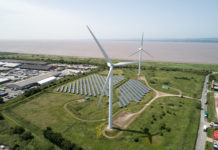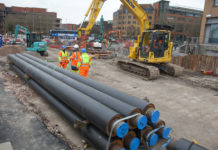
Decarbonising the UK economy will require a massive increase in clean hydrogen production, according to the Committee on Climate Change’s head of carbon budgets.
Speaking at an update of the HyNet project, David Joffe said the UK is “world class at setting emissions reduction targets” but must start delivering immediately to meet them.
To reach net zero requires multiple technologies and solutions and a “concerted package of action and new policies”, said Joffe, with hydrogen and carbon capture and storage (CCS) “pretty important”.
Electrifying heat and transport will “probably require a doubling of the electricity system,” said Joffe. “But that is not enough. We need to go from a bit of low carbon hydrogen to making it all low carbon, and having ten times as much.”
Much of that increase “will have to come from hydrocarbons plus CCS,” because producing hydrogen purely via electrolysis and renewables “would require a tripling of the electricity system … So we need CCS.”
Net zero is “really hard and we probably cant do it by 2025 or 2030,” said Joffe. Even to hit net zero by 2050 requires immediate concerted action.
“The first ten years is really important, otherwise you can wave goodbye to the target … So we need to get on with it,” said Joffe.
“There is an awful lot to do in the next ten years and one of the critical parts is infrastructure – and hydrogen and CCS are two of the key aspects.”
Beis: Private sector will pick up tab
Beis director general for energy transformation and clean growth, Julian Critchlow, spoke at the same event.
He suggested £700bn-£800bn would be required to decarbonise the economy. “We are not going to put that to Treasury, it will largely come from private investors, as it has in the wind sector, but we need to create the [enabling] framework,” said Critchlow.
While all technologies and pathways towards decarbonisation “are still on the table”, Critchlow said hydrogen “could have major implications in many industries”, with “significant export opportunities … and that is why we are so passionate about it”.
The HyNet project aims to build hydrogen plus CCS infrastructure in the North West, piping out emissions to be buried in the Irish Sea off Liverpool Bay, initially in the Hamilton Field.
The plan is to have a “shovel ready” project by 2021 if the regulatory investment framework is in place, according David Parkin, director at Progressive Energy, with first CO2 being transported through the system and a cluster “up and running by 2025”.
Parkin claimed the project “will take CO2 out of the UK economy at a lower price than virtually anything else you can do … it beats heat pumps and it beats new nuclear”.
However, the project “needs a revenue support mechanism to make it investible,” said Parkin, “policy that investors can hang their hat on in short order.”
Related stories:
Ceres claims first ‘zero emissions’ hydrogen-fuelled CHP system
Green hydrogen: How to get there
Net Zero: How to decarbonise heat?
Opinion: 10 policy steps to drive a low carbon heat market
Net Zero: Bristol’s £5bn decarbonisation plan
Ofgem CEO: Decarbonising heat the biggest energy challenge
Shell on battery storage subsidies and why gas is here to stay
Cadent outlines hydrogen plus CCS plan
Hydrogen for heat ‘will create anchor CCS projects’
Iain Conn: We will use a lot more gas before we use less
Electrifying heat: too expensive or too little ambition?
Eon boss: Renewable power is ‘done’, now for heat and transport
Hydrogen for heat will create anchor carbon capture and storage projects
Vattenfall backs hydrogen to decarbonise heavy industry
Hydrogen: The great white hope?
Ovo aims to unlock 12GW of flex from domestic storage heaters
Clydebank scheme goes large on heat pumps
Emerging solutions: Can wind, rocks, coal mines and salt decarbonise heat?
Follow us at @EnergystMedia. For regular bulletins, sign up for the free newsletter.




All the energy experts seem to be missing the point, which is that energy delivery in all its forms must be as electricityby 2050, with some delivered by ground sourced heat pumps that extract it from the earth, are there are no credible plans to convert enough all generation to carbon free. As an example, here in the UK our present total energy generation is amount 2,234 TWh but total electricity genaration including wind, solar hydro etc is only 332.9 TWh of which the renewables are only 110 TWh, so we have to increase our renewable electricity production by about 20 times to meet zero carbon by 2050. That can’t be done by wind, solar, hydro etc alone, so here in the UK there needs to be a massive building of nuclear power stations (which do not emit CO2) to fill the gap of 2,124 TWh. We have just one fission plant under construction and it will be another 8 years before it starts full generation of 3.2 TWh running 24/7.
In the US you have a much greater opportunity to build up your solar thermal and PV generation, but I guess there will still need to be a lot more nuclear power needed, and hopefully the power stations will be built in a way that the fission reactors can be replaced by fusion reactors when they are commercially available.
The head line figure only refers to the increase in hydrogen production to meet the demand for domestic uses and does not include the requiremnts of industry, transport and the vast increases in power generation.